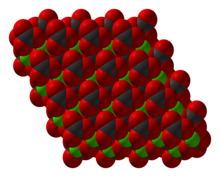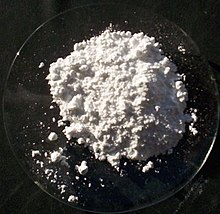Term: Calcium carbonate
– Properties:
– Chemical formula: CaCO
– Molar mass: 100.0869 g/mol
– Appearance: Fine white powder or colorless crystals; chalky taste
– Odor: Odorless
– Density: 2.711 g/cm (calcite), 2.83 g/cm (aragonite)
– Melting and Boiling Points:
– Melting point: 1,339°C (2,442°F; 1,612K) (calcite), 825°C (1,517°F; 1,098K) (aragonite)
– Boiling point: Decomposes
– Solubility in water: 0.013 g/L (25 °C)
– Solubility product: 3.3×10
– Solubility in dilute acids: Soluble
– Acidity and Magnetic Susceptibility:
– Acidity (pH): 9.0
– Magnetic susceptibility: -3.82×10 /mol
– Refractive index: 1.59
– Data provided for materials at standard state (25°C [77°F], 100kPa)
– Uses:
– Common in rocks as calcite and aragonite
– Found in chalk, limestone, eggshells, and shells
– Used in agricultural lime
– Component of pearls and shellfish skeletons
– Materials with high calcium carbonate content are calcareous
– Other Information:
– Active ingredient in agricultural lime
– Chemical compound with versatile applications
– Key component in various natural substances
– Important role in geological formations
– Widely distributed in nature
Calcium carbonate is a chemical compound with the chemical formula CaCO3. It is a common substance found in rocks as the minerals calcite and aragonite, most notably in chalk and limestone, eggshells, gastropod shells, shellfish skeletons and pearls. Materials containing much calcium carbonate or resembling it are described as calcareous. Calcium carbonate is the active ingredient in agricultural lime and is produced when calcium ions in hard water react with carbonate ions to form limescale. It has medical use as a calcium supplement or as an antacid, but excessive consumption can be hazardous and cause hypercalcemia and digestive issues.

| |
 | |

| |
| Names | |
|---|---|
| IUPAC name
Calcium carbonate
| |
| Other names | |
| Identifiers | |
3D model (JSmol)
|
|
| ChEBI | |
| ChEMBL | |
| ChemSpider | |
| DrugBank | |
| ECHA InfoCard | 100.006.765 |
| EC Number |
|
| E number | E170 (colours) |
| KEGG | |
PubChem CID
|
|
| RTECS number |
|
| UNII | |
CompTox Dashboard (EPA)
|
|
| |
| |
| Properties | |
| CaCO3 | |
| Molar mass | 100.0869 g/mol |
| Appearance | Fine white powder or colorless crystals; chalky taste |
| Odor | odorless |
| Density | 2.711 g/cm3 (calcite) 2.83 g/cm3 (aragonite) |
| Melting point | 1,339 °C (2,442 °F; 1,612 K) (calcite) 825 °C (1,517 °F; 1,098 K) (aragonite) |
| Boiling point | decomposes |
| 0.013 g/L (25 °C) | |
Solubility product (Ksp)
|
3.3×10−9 |
| Solubility in dilute acids | soluble |
| Acidity (pKa) | 9.0 |
| −3.82×10−5 cm3/mol | |
Refractive index (nD)
|
1.59 |
| Structure | |
| Trigonal | |
| 32/m | |
| Thermochemistry | |
Std molar
entropy (S⦵298) |
93 J/(mol·K) |
Std enthalpy of
formation (ΔfH⦵298) |
−1207 kJ/mol |
| Pharmacology | |
| A02AC01 (WHO) A12AA04 (WHO) | |
| Hazards | |
| NFPA 704 (fire diamond) | |
| Lethal dose or concentration (LD, LC): | |
LD50 (median dose)
|
6450 mg/kg (oral, rat) |
| NIOSH (US health exposure limits): | |
PEL (Permissible)
|
TWA 15 mg/m3 (total) TWA 5 mg/m3 (resp) |
| Safety data sheet (SDS) | ICSC 1193 |
| Related compounds | |
Other anions
|
Calcium bicarbonate |
Other cations
|
|
Related compounds
|
Calcium sulfate |
Except where otherwise noted, data are given for materials in their standard state (at 25 °C [77 °F], 100 kPa).
| |


